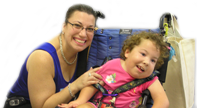Neurodevelopmental Behavior
Children's Hospital Intellectual and Developmental Disabilities Research CenterCenter URL: https://iddrc.org/
Core URL: http://www.iddrc.org/cores/neurodevelopmental-behavioral/
Core Personnel
: Trishala Chari , BSc
: Sophie Griswold , BSc
Core Director: Michela Fagiolini, PhD
Core Manager: Nick Andrews, Ph.D.
The Neurodevelopmental Behavior Core was designed to provide a time-efficient and cost-effective service for the comprehensive characterization of complex behaviors in mouse models of neurodevelopmental disorders, and for testing novel therapeutic drugs and interventions in mouse models of these human disorders. The NBC provides the necessary equipment, protocols and technical support for studying neurodevelopmental disorders, focusing not just on "snapshots" but changes in developmental milestones over time. The Core is equipped to perform extensive batteries of behavioral tests that phenotype specific social, emotional and cognitive behaviors, as well as motor, auditory and visual function, together with measures of the general health of the animals. This behavior facility also provides a unique opportunity for training fellows, graduate and undergraduate students as well as PIs.
The Neurodevelopmental Behavior Core offers in vivo analysis of mouse models of neurodevelopment and adult disorders of (primarily) the CNS. The Core performs experiments for people or trains people to do them by themselves. The core also analyses behavior (anxiety, depression, cognition, motor, vision, hearing, social communication). In addition the Core provides optogenetic capability, EEG capability, ECG measurement in conscious mice, plethysmography inconscious mice and modified housing environments (isolation from light, isolation from sound, standardized enrichment). The Core also offers surgical services such as CNS injections and CNS implants.
General Phenotyping
For establishing any gross phenotypic observations in new strains we use the SHIRPA test.
Physiological Monitoring
EEG (telemetry system (DSI) and tethered (Pinnacle), Plethysmography (EMKA), ECG (Mouse Specifics), Ultrasonic Vocalization (Sonotrack, Metris)
Motor Function and Acoustic Startle Reflex
Rotarod, beam walk, ActiTrack locomotor activity (Harvard Apparatus), Digigait (Mouse Specifics), Treadmill, Grip Strength Meter, Startle reflex & Pre-pulse inhibition (Kinder Scientific)
Vision
Optomotor for measuring visual acuity (Cerebral Mechanics), Visual Water Maze, Visual Cliff
Learning and Memory
Contextual Fear Conditioning (Stoelting), Morris Water Maze, Water T Maze, Y Maze, Novel Object Recognition
Touchscreens for testing cognitive function (Lafayette Instruments)
Emotional Behavior
3-Chamber Sociability Test, Open field, Elevated Plus Maze, Light/Dark Box, Holeboards, Forced Swim, Tail Suspension, Conditioned Place Preference
Modified Environments and Home Cage Activity
Dark Rearing, Standardized Enrichment (Viewpoint Life Sciences), Inframot (TSE), Activity wheels (TSE)
Video Tracking
We use the latest version of Ethovision XT (v12) for video tracking, recording and analysis of behavior
Last Edited: 01/03/17 12:00 AM by Theresa Trapilo







